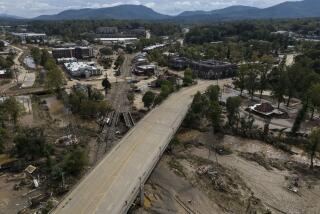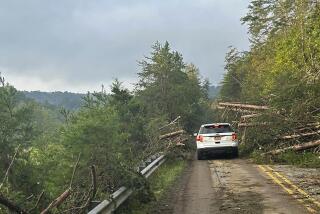Southern States Trying to Recover From Ivan
- Share via
PENSACOLA, Fla. — Shellshocked Floridians began to clean up after their third hurricane pummeling in five weeks Friday, while Alabamans looked at the crumbled condos and shattered beach homes along their coast and wondered how many months it would take for life to get back to normal.
The hurricanes have left most of Florida a disaster area, and the recovery from Ivan has been complicated by widespread power outages, washed-out roads and bridges, and ongoing gas shortages. In some areas, emergency workers had to be flown in by helicopter, and authorities said it could take weeks to restore water, power and sewer services in parts of the hard-hit Panhandle.
“You’ve got to take the bad with the good,” said Tracie Stitt, 42, who stood in a pile of cinderblock and tile that had been her home, which she and her husband shared with his parents near Perdido Bay.
“If you live in California it’d be earthquakes, if you live in Kansas it’d be tornadoes, up north it’s snowstorms,” she said. “There’s not a perfect place on earth. You’ve just got to take your losses and pray and go on.”
Ivan was the deadliest hurricane to hit the United States since Floyd in 1999. In all, Ivan was blamed for 70 deaths in the Caribbean and at least 38 in the United States, 14 of them in Florida.
On the Alabama coast, the floodwaters of Ivan that turned beach playgrounds into huge lakes began to recede, revealing widespread wreckage. At Gulf Shores, some homes were swept over a beach road littered with thousands of air conditioning units, boards and roofing shingles.
“For a lot of people it will be a real struggle to be ready before Memorial Day,” Mayor David Bodenhamer said.
Gov. Bob Riley, who toured the area Friday, said he was “absolutely shocked at the devastation” but promised a swift, full cleanup and recovery.
“This is the gem of the South,” Riley said. “We’ve got to clean it up as quickly as we can.”
More than 750,000 Alabama homes and businesses remained without power Friday afternoon, down from the state record 1.1 million power outages reported after Ivan roared through the state Thursday.
In Florida, Ivan struck when the state was still reeling from Hurricanes Charley and Frances. Charley ravaged the state’s west coast five weeks ago, while Frances pounded the east over Labor Day weekend.
Insurance experts put Ivan’s damage between $3 billion to $10 billion. Charley and Frances had combined estimated insured damages between about $11 billion and $13 billion.
Hurricane Ivan damaged or destroyed hundreds of homes and forced people to endure long lines and long detours throughout the Panhandle.
Much of the Florida Panhandle could be without power for weeks because of destroyed and damaged lines, poles and stations -- affecting everything from the delivery of water to the use of air conditioning.
Gov. Jeb Bush deployed about 2,000 National Guard troops. His brother, President Bush, was expected to visit the area Sunday -- the president’s third trip to review hurricane damage in Florida.
“I would think that when they do the final assessment, this is like Charley but a bigger area,” the governor said.
In Milton, Fla., George Campbell got his first view Friday of what life would be like for a couple of weeks -- sitting in traffic on Highway 90 that backed up for miles with people desperate to get ice and water.
“My main concern? Just get our way of life back to normal,” said Campbell, who retired from the Air Force in this region, dotted by Air Force and Navy bases and home to thousands of military retirees.
Naval Air Station Pensacola suffered massive damage, estimated in the hundreds of millions of dollars, during the storm, the Navy said Friday. Ninety percent of the buildings on the base incurred “significant” damage, although no one at the base was reported injured, according to a Navy statement.
The Navy’s chief aviation training center, located at Pensacola, was completely underwater. The Coast Guard station was destroyed. The base hospital was intact but lost 80% of its roof.
Some of the military aircraft stationed in the Pensacola area had been flown out ahead of the storm, but other aircraft left behind may have been damaged.
Ivan weakened after coming ashore with 130 mph winds early Thursday, but it continued to spin off tornadoes and cause flooding across the South, already soggy after Charley and Frances. More than a million people were without power across eight states.
Among those flooded out of their homes was a 1,000-pound alligator that disappeared from a small coastal zoo in Alabama. The 14-foot gator, named Chucky, was one of nine alligators believed to have gotten out of the Alabama Gulf Coast Zoo during flooding, said zoo general manager Kate Ramon.
“We keep Chucky well fed, so he’s normally not dangerous. But he’s out now and he’s dangerous. We’ve got to find him,” she said.
The state was praying that Ivan would be the last of the hurricane season’s devastation. Out in the Atlantic, Tropical Storm Jeanne churned on a track toward landfall within a week in the southeastern United States -- and, possibly, Florida.
Even farther out, Tropical Storm Karl strengthened Friday in the far eastern Atlantic, but posed no immediate threat to land.
*
Associated Press reporters Brent Kallestad, Bill Kaczor and Matt Crenson in Florida, and Russ Bynum, Jay Reeves and Bob Johnson in Georgia contributed to this report.
More to Read
Sign up for Essential California
The most important California stories and recommendations in your inbox every morning.
You may occasionally receive promotional content from the Los Angeles Times.













